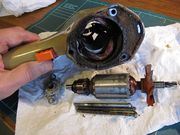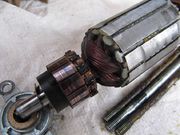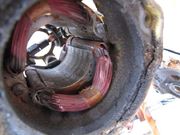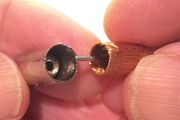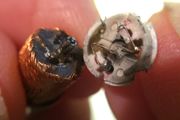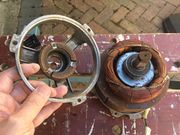Electric motors: Difference between revisions
mNo edit summary |
No edit summary |
||
| (18 intermediate revisions by 2 users not shown) | |||
| Line 1: | Line 1: | ||
This page covers electric motors of various types, how to identify them and understand their common failure modes, and how to test them. | |||
<div class="showtoc"> | |||
__TOC__ | |||
</div> | |||
==Summary== | ==Summary== | ||
Many devices and appliances contain electric motors. This page will help you understand how they work, what can go wrong, and how to fix them. | Many devices and appliances contain electric motors. This page will help you understand how they work, what can go wrong, and maybe how to fix them. | ||
===Safety=== | ===Safety=== | ||
[[File:Warning03.png|30px|left]] | [[File:Warning03.png|30px|left]] | ||
::Motors in domestic appliances can be quite powerful, and along with associated gears and mechanisms, can cause injury. As with all mains electrical appliances, it is essential to unplug them before starting work. | ::Motors in domestic appliances can be quite powerful, and along with associated gears and mechanisms, can cause injury. As with all mains electrical appliances, it is essential to unplug them before starting work. The appliance should be [[PAT testing|PAT tested]] both before and after any disassembly or repair is attempted. | ||
==Types of Motor== | ==Types of Motor== | ||
| Line 19: | Line 24: | ||
The stator is a permanent magnet or an electromagnet. | The stator is a permanent magnet or an electromagnet. | ||
In the simplest toy motors, the rotor is another coil, or a whole series of coils in all practical motors. | In the simplest toy motors, the rotor is another coil, or a whole series of coils in all practical motors, wound around a laminated iron core. | ||
A pair of carbon '''brushes''' supply current to the rotor via a '''commutator''', which continually switches the current in the rotor | A pair of carbon '''brushes''' supply current to the rotor via a '''commutator''', which continually switches the current in the rotor into whichever coils are at right angles to the stator coil at any given moment. This produces a continuous turning force. | ||
In an '''electronically commutated''' motor, the rotor is often a permanent magnet. Electronic circuits sense the rotor position and continually switch the current in a series of stator coils in order to turn the rotor. This avoids the need for any electrical connection to the rotor and so | In an '''electronically commutated''' or '''brushless''' motor, the rotor is often a permanent magnet. Electronic circuits sense the rotor position and continually switch the current in a series of stator coils in order to turn the rotor. This avoids the need for any electrical connection to the rotor and so increases the reliability. | ||
DC and universal motors work equally well as dynamos, and generate a voltage which opposes the applied voltage. | [[Glossary:DC|DC]] and universal motors work equally well as dynamos, and generate a [[Glossary:Volt|voltage]] which opposes the applied voltage. This is known as a "back emf (electro-motive force)". Under a light load, these motors speed up until they are generating nearly as much voltage as is applied. Consequently, it's easy to vary the speed just by varying the applied voltage. | ||
The commutator and brushes (except in electrically commutated motors) are subject to wear and can produce sparks. Such motors are therefore not used where the highest reliability is required or where there is a risk of fire or explosion from flammable gasses. | The commutator and brushes (except in electrically commutated motors) are subject to wear and can produce sparks. Such motors are therefore not used where the highest reliability is required or where there is a risk of fire or explosion from flammable gasses. | ||
The dynamo effect is at a minimum when the motor first starts and before it reaches full speed. This allows the motor to draw a heavy current and generate a very large starting torque (i.e. turning force). | The dynamo effect is at a minimum when the motor first starts and before it reaches full speed. This allows the motor to draw a heavy current and generate a very large starting torque (i.e. turning force). This is particularly useful in electric vehicles and trains where a powerful force is needed to initially set them in motion. | ||
[[File:Coreless_motor1.jpg|180px|thumb|right|A coreless motor - rotor and shell with permanent magnet visible inside the shell.]] | |||
In a '''coreless motor''' the rotor windings are formed into a resin bonded hollow cylinder - there is no iron core. This rotates around a static permanent magnet located within it. The magnetic field passes from one pole of the magnet through the rotor windings and then returns through the steel motor case, once again through the opposite side of the rotor and hence back to the other pole of the magnet. | |||
[[File:Coreless_motor2.jpg|180px|thumb|left|A coreless motor - Commutator and brushes.]] | |||
The current is fed to the rotor through brushes and a commutator just as in any other DC or universal motor. The absence of an iron core improves efficiency, saves weight and reduces inertia, allowing very rapid accelleration and decelleration. | |||
Coreless motors are often found in small quadrocopters and other toys as well in medical equipment, robotics and whenever a small highly efficient and responsive motor is required. | |||
Most hand power tools use universal motors. Computer fans | Most hand power tools use universal motors. Computer fans, hard disk motors and larger quadrocopter and remote control models generally use electronically commutated motors. | ||
There is an excellent [http://woodgears.ca/motors/dc.html article] with an included video describing and demonstrating how a DC motor works. | There is an excellent [http://woodgears.ca/motors/dc.html article] with an included video describing and demonstrating how a DC motor works. | ||
===Induction Motors=== | ===Induction Motors=== | ||
These are simpler in construction but not quite so easy to understand. | |||
If you move a magnet across a piece of metal, the moving magnetic field generates a circulating electric current in the metal. This current, in turn, creates a magnetic field which interacts with the applied field in such a way as to create a drag, opposing the motion. | |||
[[File:Img_1887a.jpg|180px|thumb|right|A small shaded pole induction motor, dismantled.]] | [[File:Img_1887a.jpg|180px|thumb|right|A small shaded pole induction motor, dismantled.]] | ||
The stator consists of two or more coils arranged to create a rotating magnetic field. The rotor contains a number of thick copper loops to maximise the drag created by the rotating magnetic field. The rotor speeds up until it's spinning nearly as fast as the rotating magnetic field. | |||
Induction motors only work on an [[Glossary:AC|AC]] supply (which reverses in direction 100 times per second), as this is how the stator can produce a rotating magnetic field. | |||
Since the frequency of the AC supply is fixed, you can't easily vary the speed of an induction motor. However, with 4 or 6 (or more) stator coils instead of 2, and by switching the way the AC supply is fed to them, it's possible to arrange for the rotating magnetic field to rotate at half, third (or some other fractional) speed. | |||
In most induction motors the stator produces more of an up and down than a true rotating magnetic field, but with a bit of a twist one way on the way up and the other on the way down. This means that the starting torque is low. Hence they are normally used where this doesn't matter, e.g. in a fan, which encounters little air resistance until it reaches full speed. | |||
The | [[File:Induction motor with starter winding.jpg|180px|thumb|left|An induction motor with starter winding.]] | ||
There are several ways in which the twist is obtained. In a shaded pole motor a thick loop of copper is wound around a portion of each pole (as can be seen in the first photo). This causes the magnetisation of that portion of the pole to be delayed slightly by the build up of current in the loop, so giving the required twist. The copper loop wastes power so this method is only used in small motors such as are very commonly found in desk fans. | |||
Larger motors have a second stator winding offset from the main one, which is fed with an out of phase current. A [[Basic_electronic_components#Capacitors|capacitor]] (a large cylindrical component which can't be missed) or sometimes a resistor provides the phase shift. The picture shows an example from a rotary lawn mower motor, with the 90 degree offset second winding clearly visible. | |||
(An interesting feature of the motor shown is that it had a braking mechanism to stop the blade rotating once the power was turned off. A metal disk is visible on the spindle with a spring underneath which pressed it against the three brake pads visible around the bearing. When power is applied, the magnetic field pulls this disk down and away from the brake pads. Corosion of the disk caused the braking action to become excessively fierce. The flats on the spindle then wore away the coresponding flats on a plastic impellor to which the blade was attached. The angular momentum of the blade then caused its retaining bolt to work loose.) | |||
The second stator winding may waste energy once the motor has started and hence may be switched out by a centrifugal switch. Alternatively there may be a thermistor which quickly heats up with the current flow and as it does so, its resistance increases so reducing the current in the second stator winding. | |||
Large industrial multi-horsepower induction motors are often fed from a 3-phase supply. With 3 windings (or a multiple of 3) fed from the 3 phases, these naturally create a rotating magnetic field and so are self-starting. | |||
There is an excellent [http://woodgears.ca/motors/ac.html article] with included video describing and explaining how induction motors work. | There is an excellent [http://woodgears.ca/motors/ac.html article] with included video describing and explaining how induction motors work. | ||
| Line 65: | Line 80: | ||
Imagine two tin cans, one inside the other. If you fill the space in between with treacle and rotate the outer can, it will drag the inner one around with it even if you resist its motion. The difference in speed will depend on the resistance you apply. That's like an induction motor. If instead of treacle, you attach the inner can to the outer one with springs, the inner will be forced to rotate at the same speed, but will stretch the springs and lag in position, though not in speed, as you increase the resistance. This is like a synchronous motor. | Imagine two tin cans, one inside the other. If you fill the space in between with treacle and rotate the outer can, it will drag the inner one around with it even if you resist its motion. The difference in speed will depend on the resistance you apply. That's like an induction motor. If instead of treacle, you attach the inner can to the outer one with springs, the inner will be forced to rotate at the same speed, but will stretch the springs and lag in position, though not in speed, as you increase the resistance. This is like a synchronous motor. | ||
Since a synchronous motor doesn't work properly until the rotor gets up to speed, some cunning means must be applied to get it started. | Small synchronous motors are used in electro-mechanical timers and mains electric clocks where their rotation is locked to the [[Glossary:Frequency|frequency]] of the [[Glossary:AC|AC]] mains. Large industrial plant also sometimes uses very much bigger and more powerful synchronous motors in which the rotor is in fact an [[Glossary:Electromagnet|electromagnet]] fed with [[Glossary:DC|DC]]. A car alternator and the generators in a power station are synchronous motors being used as generators. | ||
Since a synchronous motor doesn't work properly until the rotor gets up to speed, some cunning means must be applied to get it started. In small clock and timer motors this is usually achieved by the way the iron of the stator is shaped. As the magnetic field from the stator coil reverses with each cycle of the AC supply, the reversal of magnetism spreads progressively through the specially shaped iron in such a way as to give it a twist. Some older mains electric clocks contain a mechanism you have to activate in order to give the rotor an initial kick to get it started. | |||
===Reluctance Motors=== | |||
Some synchronous motors are in fact [[Glossary:Magnetic Reluctance|reluctance]] motors. The difference is that whereas the rotor of a synchronous motor is a permanent magnet, in a reluctance motor it simply consists of a shaped piece of iron. This is dragged round in just the same way as it continually tries to align itself with the rotating magnetic field. | |||
===Brushless Motors=== | |||
A brushless motor is in fact just a synchronous motor driven by an electronic circuit to drive the stator coils and so create the rotating magnetic field. The electronic circuit can quite easily control the speed of the motor by varying the frequency of the power it supplies to the stator windings. Quadcopters (apart from the small toy ones with coreless motors) generally use brushless motors. | |||
===Stepper Motors=== | |||
Often, there is a requirement for a motor which, instead of turning continuously, can be commanded to turn by a predefined amount and stop. An example is the motor which drives the paper feed rollers in a printer. These must advance the paper by the width of the print head and stop after each row of pixels is printed. Similarly, an analogue quartz clock or watch usually steps its second hand on by a second every second. Stepper motors are used in both cases. | |||
There are different configurations but the simplest and easiest to understand consists of a stator comprising two coils at right angles, and a permanent magnet rotor within them. Initially, one coil is energised and the permanent magnet lines up with its magnetic field. If the other coil is also energised the magnet will turn 45 degrees to a position between the two, and complete the 90 degree turn when the first coil is turned off. Re-energising the first coil in the opposite direction will cause the rotor to continue another 45 degrees, and so on. In this way, a shaft attached to the permanent magnet can be turned 45 degrees at a time as needed. By reversing the sequence, it can be turned in the reverse direction if this is required. | |||
==Fault finding and Repair== | ==Fault finding and Repair== | ||
All types of motor can jam if the bearings become clogged with dirt or dust, as can easily happen in power tools. Shavers, electric toothbrushes and kitchen appliances can seize up through ingress of water etc. Cleaning may be all that is required, but in the case of water, preventing the same happening again can be challenging. Investigate whether replacement seals are available. A seized bearing can often be freed with WD40, and a ball race clogged with dust can be cleaned with white spirit, but in either case, it's important to lubricate with suitable oil or grease once clean and dry, as neither WD40 nor white spirit are good lubricants. | All types of motor can jam if the bearings become clogged with dirt or dust, as can easily happen in power tools. Shavers, electric toothbrushes and kitchen appliances can seize up through ingress of water etc. Cleaning may be all that is required, but in the case of water, preventing the same happening again can be challenging. Investigate whether replacement seals are available. A seized bearing can often be freed with WD40, and a ball race clogged with dust can be cleaned with white spirit, but in either case, it's important to lubricate with suitable oil or grease once clean and dry, as neither WD40 nor white spirit are good lubricants. | ||
Small motors designed to run off batteries are often not designed to be taken apart | Small motors designed to run off batteries are often not designed to be taken apart though it may be possible to do so by bending the lugs that secure tham. Larger ones such as those intended for running off the mains can often be disassembled by removing two long bolts running through their length. In the case of DC and universal motors, on reassembly you will need to remove the brushes or hold them out of the way in order to slide the rotor into place with the commutator between them. | ||
If seized up, a motor draws a heavy current. It is designed to do so momentarily as it starts, but if prevented from turning it may overheat and damage the insulation, and in the worst case, burn out the windings. A burning smell is a strong indication of trouble, and damaged insulation may result in an inconsistent speed. If there's any evidence of deterioration of insulation the motor should be scrapped. (Specialist firms rewind large industrial motors but it's unlikely to be cost-effective for a domestic motor, nor a simple task to undertake yourself.) | |||
If | If there are no visible signs of deterioration it's worth testing the windings with a [[Glossary:Multimeter|multimeter]] on a [[Glossary:Resistance|resistance]] range. A low reading is normal as the applied [[Glossary:Volt|voltage]] is limited not by the resistance of the windings but by the dynamo effect which always opposes it. | ||
A common fault with DC and universal motors is wear of the carbon brushes which make contact with the commutator, or a dirty commutator. Excessive sparking is a sure sign that maintenance is urgently needed. The brushes are normally pressed against the commutator with a spring, but they may cease making good contact if they wear right down or if they are prevented from sliding down within their housings as they wear. Replacements can be obtained but you will need to take care selecting the right size. Replacements may be available for your specific make and model of appliance, otherwise, carefully measure the old brushes and their housing and you should be able to find suitable replacements online. If a brush wears right down to the spring the sparking is likely to permanently damage the commutator. | |||
Some professional and high-end DIY power tools have brushes which contain an embedded spring-loaded plastic pin. When the carbon wears down to its limit the pin is released, pushing the worn out brush away from the commutator to prevent further wear and permanent damage. Professionals have been known to discard expensive power tools which have suddenly stopped working for this reason - an easy fix if you can recognise the problem. | |||
Shaded pole induction motors are usually very reliable, but capacitor, thermistor and centrifugal mechanisms for starting may develop faults. If there is a capacitor, test | Shaded pole induction motors are usually very reliable, but capacitor, thermistor and centrifugal mechanisms for starting may develop faults. If there is a capacitor it may show obvious signs of distress, otherwise test it if you can. If nothing else, you can use a multimeter on a resistance range to test that it isn't shorted. | ||
An electric motor contains lots of copper and iron - make sure you recycle it responsibly! | An electric motor contains lots of copper and iron - make sure you recycle it responsibly! | ||
[[Category:Theory]] | [[Category:Theory]] | ||
Latest revision as of 21:35, 9 October 2022
This page covers electric motors of various types, how to identify them and understand their common failure modes, and how to test them.
Summary
Many devices and appliances contain electric motors. This page will help you understand how they work, what can go wrong, and maybe how to fix them.
Safety
- Motors in domestic appliances can be quite powerful, and along with associated gears and mechanisms, can cause injury. As with all mains electrical appliances, it is essential to unplug them before starting work. The appliance should be PAT tested both before and after any disassembly or repair is attempted.
Types of Motor
There are many types of electric motor but nearly all fall into three main types. They all have two main components:
- The Rotor - the bit that spins, and
- The Stator - the bit that doesn't spin.
They all rely on electromagnetism. When an electric current flows through a coil of wire it creates a magnetic field. The coil is usually wound around an iron core which then gets magnetised, greatly increasing the magnetism.
DC and Universal (AC/DC) Motors
The stator is a permanent magnet or an electromagnet.
In the simplest toy motors, the rotor is another coil, or a whole series of coils in all practical motors, wound around a laminated iron core.
A pair of carbon brushes supply current to the rotor via a commutator, which continually switches the current in the rotor into whichever coils are at right angles to the stator coil at any given moment. This produces a continuous turning force.
In an electronically commutated or brushless motor, the rotor is often a permanent magnet. Electronic circuits sense the rotor position and continually switch the current in a series of stator coils in order to turn the rotor. This avoids the need for any electrical connection to the rotor and so increases the reliability.
DC and universal motors work equally well as dynamos, and generate a voltage which opposes the applied voltage. This is known as a "back emf (electro-motive force)". Under a light load, these motors speed up until they are generating nearly as much voltage as is applied. Consequently, it's easy to vary the speed just by varying the applied voltage.
The commutator and brushes (except in electrically commutated motors) are subject to wear and can produce sparks. Such motors are therefore not used where the highest reliability is required or where there is a risk of fire or explosion from flammable gasses.
The dynamo effect is at a minimum when the motor first starts and before it reaches full speed. This allows the motor to draw a heavy current and generate a very large starting torque (i.e. turning force). This is particularly useful in electric vehicles and trains where a powerful force is needed to initially set them in motion.
In a coreless motor the rotor windings are formed into a resin bonded hollow cylinder - there is no iron core. This rotates around a static permanent magnet located within it. The magnetic field passes from one pole of the magnet through the rotor windings and then returns through the steel motor case, once again through the opposite side of the rotor and hence back to the other pole of the magnet.
The current is fed to the rotor through brushes and a commutator just as in any other DC or universal motor. The absence of an iron core improves efficiency, saves weight and reduces inertia, allowing very rapid accelleration and decelleration.
Coreless motors are often found in small quadrocopters and other toys as well in medical equipment, robotics and whenever a small highly efficient and responsive motor is required.
Most hand power tools use universal motors. Computer fans, hard disk motors and larger quadrocopter and remote control models generally use electronically commutated motors.
There is an excellent article with an included video describing and demonstrating how a DC motor works.
Induction Motors
These are simpler in construction but not quite so easy to understand.
If you move a magnet across a piece of metal, the moving magnetic field generates a circulating electric current in the metal. This current, in turn, creates a magnetic field which interacts with the applied field in such a way as to create a drag, opposing the motion.
The stator consists of two or more coils arranged to create a rotating magnetic field. The rotor contains a number of thick copper loops to maximise the drag created by the rotating magnetic field. The rotor speeds up until it's spinning nearly as fast as the rotating magnetic field.
Induction motors only work on an AC supply (which reverses in direction 100 times per second), as this is how the stator can produce a rotating magnetic field.
Since the frequency of the AC supply is fixed, you can't easily vary the speed of an induction motor. However, with 4 or 6 (or more) stator coils instead of 2, and by switching the way the AC supply is fed to them, it's possible to arrange for the rotating magnetic field to rotate at half, third (or some other fractional) speed.
In most induction motors the stator produces more of an up and down than a true rotating magnetic field, but with a bit of a twist one way on the way up and the other on the way down. This means that the starting torque is low. Hence they are normally used where this doesn't matter, e.g. in a fan, which encounters little air resistance until it reaches full speed.
There are several ways in which the twist is obtained. In a shaded pole motor a thick loop of copper is wound around a portion of each pole (as can be seen in the first photo). This causes the magnetisation of that portion of the pole to be delayed slightly by the build up of current in the loop, so giving the required twist. The copper loop wastes power so this method is only used in small motors such as are very commonly found in desk fans.
Larger motors have a second stator winding offset from the main one, which is fed with an out of phase current. A capacitor (a large cylindrical component which can't be missed) or sometimes a resistor provides the phase shift. The picture shows an example from a rotary lawn mower motor, with the 90 degree offset second winding clearly visible.
(An interesting feature of the motor shown is that it had a braking mechanism to stop the blade rotating once the power was turned off. A metal disk is visible on the spindle with a spring underneath which pressed it against the three brake pads visible around the bearing. When power is applied, the magnetic field pulls this disk down and away from the brake pads. Corosion of the disk caused the braking action to become excessively fierce. The flats on the spindle then wore away the coresponding flats on a plastic impellor to which the blade was attached. The angular momentum of the blade then caused its retaining bolt to work loose.)
The second stator winding may waste energy once the motor has started and hence may be switched out by a centrifugal switch. Alternatively there may be a thermistor which quickly heats up with the current flow and as it does so, its resistance increases so reducing the current in the second stator winding.
Large industrial multi-horsepower induction motors are often fed from a 3-phase supply. With 3 windings (or a multiple of 3) fed from the 3 phases, these naturally create a rotating magnetic field and so are self-starting.
There is an excellent article with included video describing and explaining how induction motors work.
Synchronous Motors
These are similar to induction motors, in that the stator creates a rotating magnetic field. The difference is that the rotor is a permanent magnet and hence is forced to rotate at the same speed as the magnetic field instead of lagging in speed as in an induction motor.
Imagine two tin cans, one inside the other. If you fill the space in between with treacle and rotate the outer can, it will drag the inner one around with it even if you resist its motion. The difference in speed will depend on the resistance you apply. That's like an induction motor. If instead of treacle, you attach the inner can to the outer one with springs, the inner will be forced to rotate at the same speed, but will stretch the springs and lag in position, though not in speed, as you increase the resistance. This is like a synchronous motor.
Small synchronous motors are used in electro-mechanical timers and mains electric clocks where their rotation is locked to the frequency of the AC mains. Large industrial plant also sometimes uses very much bigger and more powerful synchronous motors in which the rotor is in fact an electromagnet fed with DC. A car alternator and the generators in a power station are synchronous motors being used as generators.
Since a synchronous motor doesn't work properly until the rotor gets up to speed, some cunning means must be applied to get it started. In small clock and timer motors this is usually achieved by the way the iron of the stator is shaped. As the magnetic field from the stator coil reverses with each cycle of the AC supply, the reversal of magnetism spreads progressively through the specially shaped iron in such a way as to give it a twist. Some older mains electric clocks contain a mechanism you have to activate in order to give the rotor an initial kick to get it started.
Reluctance Motors
Some synchronous motors are in fact reluctance motors. The difference is that whereas the rotor of a synchronous motor is a permanent magnet, in a reluctance motor it simply consists of a shaped piece of iron. This is dragged round in just the same way as it continually tries to align itself with the rotating magnetic field.
Brushless Motors
A brushless motor is in fact just a synchronous motor driven by an electronic circuit to drive the stator coils and so create the rotating magnetic field. The electronic circuit can quite easily control the speed of the motor by varying the frequency of the power it supplies to the stator windings. Quadcopters (apart from the small toy ones with coreless motors) generally use brushless motors.
Stepper Motors
Often, there is a requirement for a motor which, instead of turning continuously, can be commanded to turn by a predefined amount and stop. An example is the motor which drives the paper feed rollers in a printer. These must advance the paper by the width of the print head and stop after each row of pixels is printed. Similarly, an analogue quartz clock or watch usually steps its second hand on by a second every second. Stepper motors are used in both cases.
There are different configurations but the simplest and easiest to understand consists of a stator comprising two coils at right angles, and a permanent magnet rotor within them. Initially, one coil is energised and the permanent magnet lines up with its magnetic field. If the other coil is also energised the magnet will turn 45 degrees to a position between the two, and complete the 90 degree turn when the first coil is turned off. Re-energising the first coil in the opposite direction will cause the rotor to continue another 45 degrees, and so on. In this way, a shaft attached to the permanent magnet can be turned 45 degrees at a time as needed. By reversing the sequence, it can be turned in the reverse direction if this is required.
Fault finding and Repair
All types of motor can jam if the bearings become clogged with dirt or dust, as can easily happen in power tools. Shavers, electric toothbrushes and kitchen appliances can seize up through ingress of water etc. Cleaning may be all that is required, but in the case of water, preventing the same happening again can be challenging. Investigate whether replacement seals are available. A seized bearing can often be freed with WD40, and a ball race clogged with dust can be cleaned with white spirit, but in either case, it's important to lubricate with suitable oil or grease once clean and dry, as neither WD40 nor white spirit are good lubricants.
Small motors designed to run off batteries are often not designed to be taken apart though it may be possible to do so by bending the lugs that secure tham. Larger ones such as those intended for running off the mains can often be disassembled by removing two long bolts running through their length. In the case of DC and universal motors, on reassembly you will need to remove the brushes or hold them out of the way in order to slide the rotor into place with the commutator between them.
If seized up, a motor draws a heavy current. It is designed to do so momentarily as it starts, but if prevented from turning it may overheat and damage the insulation, and in the worst case, burn out the windings. A burning smell is a strong indication of trouble, and damaged insulation may result in an inconsistent speed. If there's any evidence of deterioration of insulation the motor should be scrapped. (Specialist firms rewind large industrial motors but it's unlikely to be cost-effective for a domestic motor, nor a simple task to undertake yourself.)
If there are no visible signs of deterioration it's worth testing the windings with a multimeter on a resistance range. A low reading is normal as the applied voltage is limited not by the resistance of the windings but by the dynamo effect which always opposes it.
A common fault with DC and universal motors is wear of the carbon brushes which make contact with the commutator, or a dirty commutator. Excessive sparking is a sure sign that maintenance is urgently needed. The brushes are normally pressed against the commutator with a spring, but they may cease making good contact if they wear right down or if they are prevented from sliding down within their housings as they wear. Replacements can be obtained but you will need to take care selecting the right size. Replacements may be available for your specific make and model of appliance, otherwise, carefully measure the old brushes and their housing and you should be able to find suitable replacements online. If a brush wears right down to the spring the sparking is likely to permanently damage the commutator.
Some professional and high-end DIY power tools have brushes which contain an embedded spring-loaded plastic pin. When the carbon wears down to its limit the pin is released, pushing the worn out brush away from the commutator to prevent further wear and permanent damage. Professionals have been known to discard expensive power tools which have suddenly stopped working for this reason - an easy fix if you can recognise the problem.
Shaded pole induction motors are usually very reliable, but capacitor, thermistor and centrifugal mechanisms for starting may develop faults. If there is a capacitor it may show obvious signs of distress, otherwise test it if you can. If nothing else, you can use a multimeter on a resistance range to test that it isn't shorted.
An electric motor contains lots of copper and iron - make sure you recycle it responsibly!
